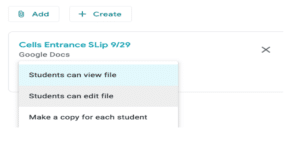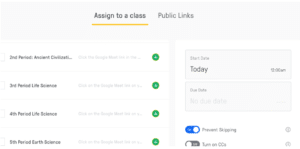Google Classroom is an awesome teaching tool that can help you deliver remote or in-person instruction effectively. The service is free, though there are various paid tiers and extras that hundreds of districts and private schools utilize. Regardless what tier you have, here are five tips to make teaching easier with Google Classroom!
1. Record and post videos of your classes or instructions
Remote learning has thrown a lot of families into hard situations. They may have to juggle multiple children using one device or ration data needed for parental jobs and student class times. Sometimes, when all is said and done, students are missing classes through no fault of their own. If you know there might be students who are absent or students who will want to rewatch lessons, there are ways to accomodate them. You can record classes, your teaching, or add educational videos.
If you use Google Meet, you can record your classes by clicking the “Record Meeting” option in Settings. Zoom will automatically record for you. Make sure you get consent from all the participants. Since it would only be posted on your own Google Classroom for your own students, privacy concerns should be minimal and may have already been covered by your school’s guidelines for technology use.
If you would like to record yourself as you provide direct instruction, modeling, reading aloud, or demonstrating how to perform a task, you can also record yourself outside of class time using Google Meet, Screencastify, Zoom, or similar services. Once you’ve got your recording ready, always watch it yourself first to catch any glitches. Then you can post it on the Stream or Classwork section of Google Classroom.
Another option is to download videos already recorded for you like these Writing Videos. They provide the instruction for you and give you the freedom to work on other plans.
A great idea is to create a special folder or drive for all of your recordings so that students can access them without too much scrolling. Students who are absent or need repetition with concepts and instructions will be able to access the instruction in one central location. Helping kids make up missed time just got much easier!
Google Meet: After you click on the three dots at the bottom right hand side of Google Meet, you will see the option for “Record Meeting” near the top.
2. Individualize Assignments and Make Collaboration Simple
Individualizing assignments for students with different learning styles or reading levels can be a challenge even in the best of situations. You want to make sure everyone gets what they need and the material is covered, but you also want to make sure you include collaborative learning in your lessons. Individualizing assignments is a streamlined process with Google Classroom.
Differentiated Assignments:
Let’s say that you have three text and question sets for your English class. All of them deal with inferring, but the levels of difficulty are different. You want all the kids to have the assignment, but you don’t want your advanced kids to do the simplified version or struggling readers to receive a version well above their comprehension level. How can you offer different versions of the same assignment when you’re not there to pass them out? It’s surprisingly easy with Google Classroom.
Select Students and Groups:
When you click on the Classwork Tab and then go to Create an assignment, you can choose to give an assignment to all students or select only certain ones. You will have to create separate assignments for each group, but students will only see the assignments given to them.
Additionally, if you have students who require enrichment or support, they will likely need different or supplemental assignments. It would be unnecessary to force all students to do these assignments. With this feature on Google Classroom, you can create specific enrichment or supportive activities and assign them just to the students who need them.
When you create an assignment, customize! Assign it to your whole class or only certain groups of students.
Learn more about differentiation here!
Collaboration:
Would you like to provide an opportunity for group collaboration for certain assignments but not on others? When you attach a document in the assignment, you can mark it as “Students Can Edit File.” Now, all the students in the group can write in one document and collaborate. Awesome option! Not only do you have an assignment specific to a small group, you can also ensure that those same students can work together by sharing the same document. As you create assignments, you’ll also be able to edit the documents directly or with comments so you can engage with your collaborators as well!
Choose to let students in small groups collaborate on the same document by allowing students to edit a file.
3. Use Google Classroom with Sites you Love and Already Use
Teachers love to find fun ways to interactively review material, assess student background knowledge, and introduce topics. Sites like Kahoot, Quizizz, Nearpod, and EdPuzzle have risen in popularity in 2020 as much of the world moved to remote learning. These sites offer the ability to use or create lessons and quizzes that students can access digitally or in the classroom. What’s more, most students seem to absolutely love them. Teachers love them too, as they are valuable assessment tools that make students happy.
Do you wish you could grade those fun-filled assessments? You can, and what’s more, you can link your Google Classes to accounts in these various sites. Once you’ve created or found a video or activity you would like to use, simply assign it to the classes you’ve imported. The assignment automatically posts in Google Classroom. Google will even send reminders to your students’ emails. Once students complete the activity you’ve assigned, the scores they earned are sent straight to Google Classroom and will appear in your grade summary! If the grade needs to be altered because you intended to give points for participation or completion as opposed to accuracy, don’t worry. You have the power to change the grade or delete the assignment through Google Classroom. Interactive, self-posting, self-grading assignments that kids love? Yes, please!
This is a screenshot of assigning a video or activity to your synced class with a single click!
4. Embed Rubrics
Communication can be a struggle in a world where we’ve lost a lot of in-person instruction. Organization can be a challenge as well. Some students move between multiple places while families are working or while instruction is delivered in a hybrid mode, where they move between classrooms and living rooms on alternating days. Sometimes organization and communication can be tricky even without these recent Pandemic Era curveballs.
Google Classroom has a simple tool that can cut down on the number of frantic parent and student emails demanding to know what the requirements are and what you’re looking for in an assignment or project. Digitally assigning classwork means they will all stay in one place, but Google Classroom also lets you embed a rubric into any assignment you post. If you create one to go along with your assignments, you can simply refer parents and students to check the guidelines and expectations contained in the rubric whenever they need to!
Here is where you embed a rubric instantly into any assignment! Learn about editable writing rubrics.
5. Give and Grade Quizzes Easily
Sometimes giving a graded quiz is a challenge if you are teaching from afar. Google Classroom allows you to create a quiz in Google Forms and then attach it as an assignment. If you go to the Classwork Tab in your Google Class, it will also give you the option to create a “Quiz Assignment.” Either way, you’re about to make your life easier!
Creating Questions:
When you create or attach a quiz, you can choose the type of questions. Multiple choice, short answer, true or false, and paragraph are options. You can mix them up or create a quiz where all of the answers are one variety. As you create the quiz, or when you’ve completed it, you can then click inside each question to create an answer key. You can also assign point values. In other words, for a few minutes of extra work once, you can have a self-grading quiz every time you use it. It is especially handy if you teach the same material in multiple sections of classes or each year. When you change some material or add to it, editing the quiz is a snap- just click inside the individual question boxes and change whatever you need to.
Engage Students:
Do you want to make your quiz more entertaining or engaging? You can add images and video clips that students can view and then answer questions about! Use the menu on the right-hand side of each question to add content. It is fun for students and self-grading for you! Win-win!
Benefits:
Some teachers have been using this function for quizzes for years. It’s a way to help students who may struggle with writing responses or holding a pencil. It helps teachers who have a limited number of copies per week, using more technology in the classroom, remote teaching, and saves time with automatic grading. I include automatic quizzes in many of my DISTANCE LEARNING RESOURCES.
Locked Mode:
But, administering tests remotely or even in-person on a computer causes some concerns. Will they stay on the right tab? Will they be tempted to look up answers on the web or go back into Google Classroom to peek at their study guides or the textbook? “Locked Mode” can assist you. When you create a quiz assignment, there will be an option to use Locked Mode. This will ensure that your students can only open the tab the quiz is on and no others once they start the quiz. It also ensures they can only submit one response. This security feature only works with devices connected to your school’s account, so it will not work if a student completes the assignment from a personal device. Request that your students use their school device if security is a concern. You can use GoGuardian or another education monitoring service to make sure your directions are carried out.
This image shows where to import grades directly from your assigned Google Forms quiz and ensure the fidelity of your student responses with Locked Mode.
Google Classroom is a valuable resource. There are so many ways to tailor it to fit your teaching style. These are just some of the tips that can make teaching easier. I hope you found one or more ideas to try with your lessons! If you need to go back to the basics of Google Classroom, check out this blog: GETTING STARTED WITH GOOGLE CLASSROOM: THE TEACHER BASICS.











